New extended visitor ID badges help patients feel like family
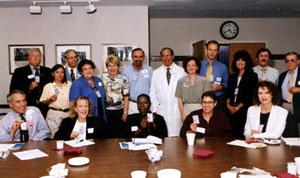 Members of the Patient Advisory Group suggested that extended visitor badges
and vehicle hangtags be available to patients who make frequent visits to the
Clinical Center.
Members of the Patient Advisory Group suggested that extended visitor badges
and vehicle hangtags be available to patients who make frequent visits to the
Clinical Center.
|
Badges, hangtags, give patients
faster access to campus
Patients now have the option to be treated like employees—at least when it comes to
passing through security checkpoints on campus and within the Clinical Center.
Extended visitor identification badges and vehicle hangtags are being
issued to patients who make frequent visits to the Clinical Center for treatments and
follow-up appointments. Similar to employee badges, extended visitor badges are light blue
and display the name and photograph of the patient.
The new hangtags and badges will eliminate the need for patients to have
their cars inspected, and reduce their wait time at the South Entrance, where they
have had to sign the visitors log, receive a pass and walk through the metal detectors.
"This is wonderful; I'm ecstatic about it," said Maureen Schultz,
a patient at the Clinical Center and member of the Patient Advisory Group. "I've been
coming here for three years. After that amount of time, you begin to feel like a part
of the Clinical Center. So it just felt awkward having to sign in and wear a visitor's
badge, although I know it was necessary."
"It's a kindness to patients," said Susan Butler, a member of the
Patient Advisory Group. "I appreciate that the Clinical Center is thinking of ways
to make life easier for patients in the midst of uncertain times."
The badges and hangtags were presented to members at the Patient Advisory
Group meeting in July.
The Patient Advisory Group was formed four years ago as a way for
all patients to make recommendations as to how the Clinical Center and its employees
can make their stay more comfortable. Based on the Patient Advisory Group recommendations,
the Clinical Center has implemented free valet parking for patients and visitors, removed
speed bumps from the P3 level garage, provided a continental breakfast service for
patients having blood drawn, instituted customer service training, and made plans to
renovate the second floor dining center.
"We do listen to our patients and we are grateful for their concern and
suggestions,"
said Clinical Center Director John Gallin. "I think this group is terrific and a
model for other hospitals to follow."
Back to Top
Project to erect perimeter fence starts in fall
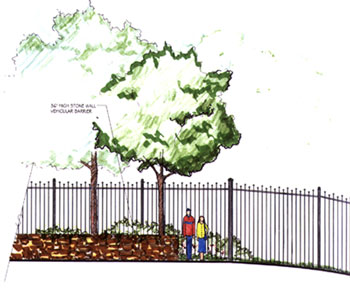 An artist's drawing of the proposed fence shows a boulder barrier
that will line the fence in various places around the campus.
An artist's drawing of the proposed fence shows a boulder barrier
that will line the fence in various places around the campus.
|
Nearly 9-foot tall fence to surround NIH campus
Anyone who has ever wondered what it's like to work at the White House will soon realize
at least a portion of that dream: NIH is due to get an ornamental metal fence of the kind
that surrounds the executive mansion, complete with surveillance cameras and other monitoring
features that will enhance security on campus.
The fence, a protection measure that was actually recommended for NIH by the HHS Office
of the Inspector General a month before the September 11 terrorist attacks, is currently
in the design phase, with construction due to begin in the fall and completion expected
next spring, said Stella Serras-Fiotes, director of the Office of Facilities Planning,
Office of Research Services.
The barrier, once considered hurtful to the collegial nature of the campus, is but one
part of a larger security scheme that will eventually include a new visitor center to
welcome and screen guests, and a delivery inspection center to monitor vendor and truck
traffic at NIH. All three elements were proposed by the IG office, and became critical for
NIH when HHS directed, on January 30, that all department facilities adhere to security
requirements (based on a "Vulnerability Assessment of Federal Facilities") developed by
the Department of Justice in June 1995, and to National Security Alert Guidelines issued
by the General Services Administration.
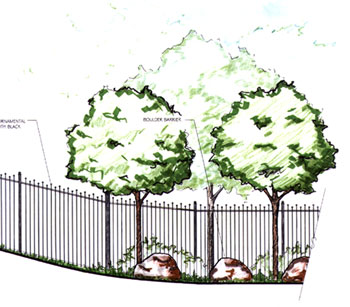 A 3-foot high stone wall will be built to prevent vehicle entry.
A 3-foot high stone wall will be built to prevent vehicle entry.
|
Though constructed of black metal pickets almost nine feet tall, and buttressed near
roadways by boulders and stone walls designed to thwart vehicles, the perimeter fence will be flexible
enough to respond to a range of threat conditions set by the Office of Homeland Security.
According to guidelines developed by the ORS Division of Public Safety, at the lowest, or
"green" level of security, the gates could be open and unstaffed, said Serras-Fiotes. At
the "red" or highest level, the gates might be locked to everyone, with entry permitted
only through specific, staffed gates. The gates can function either electronically, or
with staffing, or both, Serras-Fiotes noted, and designers are including features to foil
the practice of anyone dashing in at the same time as NIH'ers, a behavior known as
"tailgating."
While obviously a physical barrier, the fence also buys time for police in the event
of an aggressive intrusion from without. It is the outermost ring in a series of
concentric layers of protection that includes restricted entry at some buildings
as well as some areas within buildings that may be off-limits, Serras-Fiotes explained.
As it snakes its way for almost two miles around the perimeter of campus, resulting
in the demise of only a handful of trees, the fence adapts to some specific needs.
It has been routed to avoid four "archaeo-logically sensitive areas"
(one on each of the campus' four sides) and attempts to honor the perimeter buffer zone
from surrounding neighborhoods. It maintains a 100-foot "pedestrian standoff"
from NIH buildings (the distance at which a bomb-wielding walker could do minimal damage)
and a 250-foot "vehicular standoff," representing the distance at which the explosives
packed in a car or truck could do the least damage to structures. Other special features
include 3-foot-tall stone wall vehicular barriers near driveway entrances; routing to
avoid protected "view sheds"—those vistas offered from historic properties such as
Building 1 and the Stone House; and a special "residential fence" around the
on-campus homes ("the Quarters") that will both enable residents to come and go
more freely than employees, and be capable of turning the enclave into a gated
community in the event of a threat.
The perimeter fence will itself be encircled by a bikepath/sidewalk to connect
with the county's system and to accommodate neighbors who are accustomed to
traversing the
campus to reach Metro. In a boon for dog walkers and neighbors, the chain-link fence
that has for decades defined the south boundary of campus will remain with its
current openings while the new perimeter fence will be set back from the chain-link one,
leaving a greensward for common use.
Though he was not here when planning for the fence began last October,
NIH Director Dr. Elias Zerhouni endorses the decision to proceed with its
construction. In a letter to Rep. Connie Morella (R-Md.) dated June 14, he said,
"I am committed to protecting our employees, patients, visitors and neighbors;
securing our facilities; and safeguarding the reputation and mission of the NIH."
The letter further notes that NIH has been evaluating its security needs since
1995; that "significant shortcomings in NIH's security profile" have been identified;
and that nationally recognized experts in security planning and design have offered
their counsel to NIH in this process.
Planning for the fence has also involved the surrounding neighborhoods, via the
NIH Community Liaison Council, the Maryland National Capital Park and Planning
Commission, and the National Capital Planning Commission, which gets the plan in
August and might have input on aspects of design or siting. "NCPC's role is advisory
for federal facilities outside the District of Columbia," said Serras-Fiotes. NCPC
will submit the plan to the Montgomery County Planning Board, which will likely discuss
it at an open hearing in September. The board will report back to NCPC later in the fall,
and NCPC will issue its non-binding recommendations.
Once the fence is built, plans will proceed for a new freestanding visitor center near
the Medical Center Metro Station, (the current Visitor Information Center recently
migrated from the basement of the Clinical Center to a site on the first floor of the
Natcher Building) and a delivery inspection center at the northeast side of the campus.
The two must be kept separate for optimum traffic flow and security, Serras-Fiotes
emphasized.
Visitor center construction will require reconfiguration of the current Metro drop-off
and bus depot, to allow better access and circulation. Traffic studies of current and
anticipated conditions have concluded that no changes need be made to the roadways
surrounding NIH.
Eventually, some of the vehicle inspection "tents" on campus will come down, but there
will probably be a continued need for them outside underground parking garages, noted
Serras-Fiotes.
"[Security planning is] a really challenging job," she said, "because the campus was
not originally designed to be a secure place. Retrofitting [for security needs] is
tough to apply uniformly and appropriately, particularly after we've had more than 60
years of being essentially an open campus."
-by Rich McManus, NIH Record
Back to Top
Medicine for the Public Lecture Series
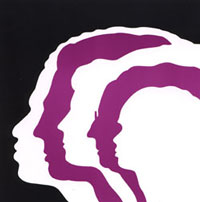
This year's Medicine for the Public lectures will be held at 7 p.m. in Masur Auditorium
on Tuesdays from September 17 through October 29.
|
Medicine for the Public lecture series returns
The 2002 Medicine for the Public lecture series, now in its 26th year, features
physician-researchers working in the frontiers of medical discovery at the National
Institutes of Health. The series helps people understand the latest developments in
medicine with an emphasis on topics of current relevance presented by speakers who can
relate stories of science to the lay public. Sponsored by the NIH Clinical Center, the
lectures are held at 7 p.m. on Tuesdays in the Clinical Center's Masur Auditorium,
National Institutes of Health, 9000 Rockville Pike, Building 10, Bethesda, Maryland.
All lectures are free and open to the public. Contact Dianne Needham at 301-496-2563
for further information on specific topics or speakers, or visit the Medicine for the
Public website
http://www.cc.nih.gov/ccc/mfp/series.html
September 17
Bioterrorism
Pierre Noel, M.D., chief, Hematology, Department of Laboratory Medicine, NIH Clinical Center
Every American citizen became sensitized to bioterrorism after the anthrax letter events
of October 2001. In a world where politics and economic trends are dictated by the United
States, biological weapons offer an asymmetric advantage to political or religious groups
waging war with the United States and the American way of life. Dr. Noel will present the
recent history of biological warfare programs, which offer a good perspective of what the
future may hold. He will also discuss the biologic and physical characteristics that may
render a biological agent a potential weapon. Anthrax, plague and smallpox are three of
the most likely organisms to be used as biological weapons. Understanding the biology,
mechanisms of toxicity, modes of spread, and current preventive and therapeutic measures,
lays the groundwork for future research in biodefense.
September 24
The Genetics of Speech and Communication Disorders
Dennis Drayna, Ph.D., senior fellow, Section on Transcription Factors, Sensory Receptors
and Channels, Laboratory of Molecular Biology, National Institute on Deafness and
Other Communication Disorders
Communication is a crucial part of everyone's life. But when someone has problems
speaking or understanding, their very existence is affected. Millions of Americans suffer
from communication disorders. In fact, stuttering affects about one percent of the U.S.
population. Dr. Drayna will explain how genes affect the ability to communicate. Specifically,
he will discuss his work with stuttering and disorders of pitch recognition-also known
as "tone deafness."
October 1
Coping with Anxiety and Depression in Uncertain Times
Dennis S. Charney, M.D., chief, Mood and Anxiety Disorder Experimental Therapeutics
and Pathophysiology Branch, National Institute of Mental Health
The experience of psychological trauma is not uncommon in today's society. Recent
research indicates that severe psychological trauma can cause persistent symptoms of
anxiety and depression. Dr. Charney will discuss these symptoms and how they affect
brain function and alter body systems, and explore current treatments available.
October 8
Nutritional Therapies for Age-Related Eye Diseases
Emily Chew, M.D., deputy director, Division of Epidemiology and Clinical Research,
National Eye Institute
Between 2000 and 2020, the number of people 65 years or older in the United States
will increase from 35 million to 53 million, a 53 percent increase. This is the
fastest growing segment of the United States. The public health significance of
age-related eye diseases such as age-related macular degeneration and cataracts
will increase. Dr. Chew will explain age-related eye diseases, their incidence, and
the results of recent studies regarding nutritional supplements for these conditions.
The public health impact of such treatment will also be assessed.
October 15
The Teen Brain
Jay Giedd, M.D., chief, Brain Imaging, Child Psychiatry Branch, National Institute of
Mental Health
Any parent of a teenager can attest to the fact that the brain of a 13-year-old is
different than the brain of a 9-year-old. Yet to actually identify those differences
in a scientific way has been elusive. Magnetic resonance imaging has changed that. It
safely provides exquisitely accurate pictures of the living, growing brain and has
launched a new era of adolescent neuroscience. Dr. Giedd will explore recent findings
from brain imaging and the implications these findings have for parents, teachers, society,
and the teens themselves.
October 29
Endometriosis: Scrambled Eggs and Killer Cramps
Pamela Stratton, M.D., chief, Gynecology Consult Service, Pediatric and Reproductive
Endocrinology Branch, National Institute of Child Health and Human Development
Endometriosis is a common gynecologic disease. Tissue resembling the lining of the uterus
grows outside of the uterus, usually on the pelvic organs. Some women find out they have
endometriosis when they have trouble becoming pregnant. Others with endometriosis have
pelvic pain with their menstrual periods or with sex. The pain may be so severe that it
impacts on their quality of life, affecting their intimate relationships and day-to-day
activities. Some women don't have any symptoms from endometriosis. The treatments are
tailored to the woman's symptoms. Women with infertility may benefit from surgery or
other assisted reproductive techniques. Those with pain may benefit from surgery or
hormonal treatments, in addition to taking medications for pain relief. Medical research
on endometriosis continues to look into improving drug therapies and surgical treatments,
but because of the complexity of the disease, there may be a long way to go before finding
a cure. Dr. Stratton explains a study investigating whether raloxifene will prevent the
return of pain after surgical treatment of endometriosis. What sets this research apart
is the study of a designer estrogen, which blocks the body's estrogen in the uterus and
therefore may prevent the regrowth of endometriosis. The researchers are also investigating
other aspects of the disease such as quality of life.
Back to Top
Bone death of hip a major concern in HIV patients
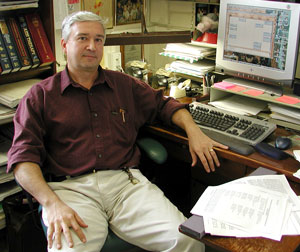 Dr. Joseph Kovacs and his team found osteonecrosis a concern in
HIV-infected individuals.
Dr. Joseph Kovacs and his team found osteonecrosis a concern in
HIV-infected individuals.
|
Kovacs leads team in successful study
A study conducted at the Warren Grant Magnuson Clinical Center, reports in the July 2
issue of the Annals of Internal Medicine that osteonecrosis of the hip may be a new and
major complication for HIV-infected people.
As HIV-related deaths and HIV-associated opportunistic infections have dramatically
decreased, attributable in large part to new drug regimens introduced over the past
decade, NIH researchers have noticed a disturbing increase in the incidence of osteonecrosis,
or "bone death," of the hip in some HIV-infected patients.
"Osteonecrosis can eventually require hip replacement," said Dr. Joseph A. Kovacs, head of
the Critical Care Medicine Department's AIDS Section, and one of the researchers guiding
the study. "We don't have a way to prevent it or treat it, except symptomatically, such as
treating pain."
With disease progression, he explained, patients often report a persistent or debilitating
pain. Eventually the dead bone collapses—a process that can take months or years. The
pain can grow increasingly severe and a hip replacement is often ultimately required.
Osteonecrosis has also been associated with systemic lupus erythematosus, sickle cell
anemia, and renal transplantation.
The NIH study began in 1999 after two HIV-infected Clinical Center patients were
diagnosed with osteonecrosis within a four-day period. At the same time, other researchers
were reporting increases in osteonecrosis in HIV-infected people, which had been first
noted about 10 years ago. Initial findings indicating the connection were released during
the first year of the study. Since then, study findings have been subject to peer review.
Also, Kovacs said, nearly 250 patients have been rescanned and additional cases of
osteonecrosis have been confirmed.
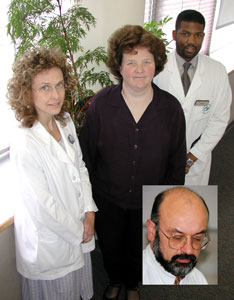
Dr. Kovacs team includes (from l-r) Elizabeth Jones, Grace Kelly, and Galen Joe;
Inset: The late Kirk Miller.
|
The study used Magnetic Resonance Imaging (MRI) to look for the characteristic lesions
in the hips of asymptomatic HIV patients. Between June and December 1999, adults
enrolled in studies at the NIH Clinical Center, or who received health care at the
National Naval Medical Center, Bethesda, Md., were invited to participate in a MRI
screening study for osteonecrosis of the hip. Those who showed symptoms of the condition, which include pain or "groin pull," a pressure of the inner thigh, were excluded.
Of 339 patients studied, 15—or 4.4 percent—were found to have osteonecrosis. This,
said Kovacs, is considered "extraordinarily high" in any random group. None of the 118
HIV-negative participants, who were matched for age and sex, was found to have it.
In searching for possible causes, researchers found an association between osteonecrosis
and the use of corticosteroids and other types of steroids such as androngenic and
anabolic steroids, as well as lipid lowering agents. Kovacs explains that these are
merely associations and that more research is required to try to find cause-and-effect
relationships.
Corticosteroids are often administered to HIV-infected patients for HIV-specific
complications such as pneumocystis pneumonia, as well as for common problems unrelated
to HIV infection, such as severe allergies, bee stings, poison ivy, and severe asthma.
The study indicated that many HIV-infected patients with osteonecrosis had been using
the corticosteroids for only a short time. Anabolic steroids, such as testosterone,
can be administered as replacement therapy in patients with testosterone deficiency
but also is often used in body building.
Kovacs calls the study a "red flag" for doctors treating HIV-infected patients, should
their patients complain of chronic hip or groin pain. He also believes doctors should be
aware of the possible associations with osteonecrosis when prescribing treatments such
as corticosteroids and testosterone in this population.
Due to the high cost of MRI scans, the unknown natural history of asymptomatic
osteonecrosis, and the lack of treatment with documented efficacy for asymptomatic
disease, the researchers at present don't recommend scanning patients unless they
complain of persistent hip or groin pain.
For the complete study report visit http://www.annals.org/issues/v137n1/full/200207020-00008.html.
-by John Iler
Back to Top
Disability Awareness Expo
Mark your calendars for Thursday, October 3, 10 a.m. to 2 p.m., when the Clinical Center
hosts a Disability Awareness Expo featuring topics on disability resources, accommodations,
assistive technology, and Section 508 compliance requirements.
The showcase will bring together management and staff to celebrate National Disability
Employment Awareness Month, a day designated by Congress to help increase the public's
awareness of contributions and skills of American workers with disabilities.
The theme this year is "The Disability Awareness Expo Can Help You!" Information resource
booths will be open to the public on the first floor and in the Visitor Information Center.
Participants can enter a drawing for two prizes. The department head with the largest
percentage of staff attendance will also win a prize. Winners will be selected at 1:45 p.m.,
but need not be present to receive the prize.
Educating the public about disability and employment issues began in 1845 when Congress
enacted a law declaring the first week in October National Employ The Physically Handicapped
Week. The word "physically" was removed in 1962 to recognize the contributions of individuals
with all types of disabilities. In 1988, Congress expanded the week to a month and changed
the name to National Disability Employment Awareness Month.
The expo is accessible to individuals with disabilities, and sign language interpretation
will be provided. For other reasonable accommodation needs, contact the disability employment
program coordinator at least five days in advance at jgarmany@nih.gov or 301-496-9100 (TTY),
or through the Maryland Relay Service at 1-800-735-2258.
Back to Top
Fauci to give Sept. 11th lecture on bioterrorism
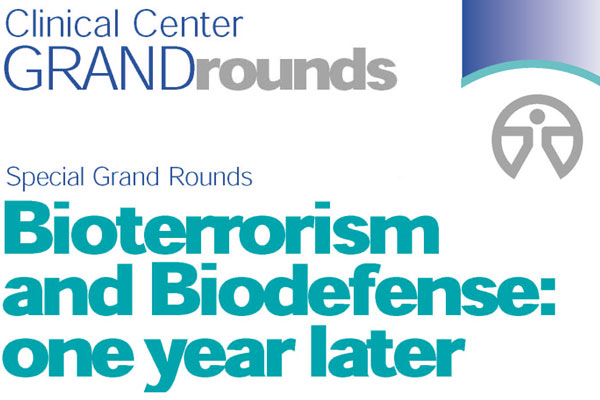 |
Wednesday, September 11, 2002
12 Noon to 1 p.m.
Masur Auditorium
Bioterrorism and Biodefense:
One Year Later
Anthony S. Fauci, M.D.
Director, National Institute of Allergy and Infectious Diseases
Lecture can be accessed on the NIH Videocast at
http://videocast.nih.gov
|
Back to Top
Clinical fellows orientation
|
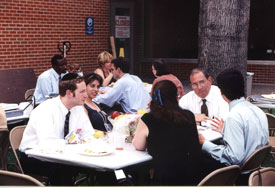
|
The annual orientation for new clinical fellows was held last month in Lipsett Amphitheater.
Sixty-three fellows from a cross-section of institutes attended the orientation, which is
designed to familiarize trainees with the programs and services that will be an integral
part of their training experience. Immediately following the orientation, a welcome
reception was held outside of the B1 level cafeteria to provide an opportunity for
NIH leadership to meet the new trainees.
|
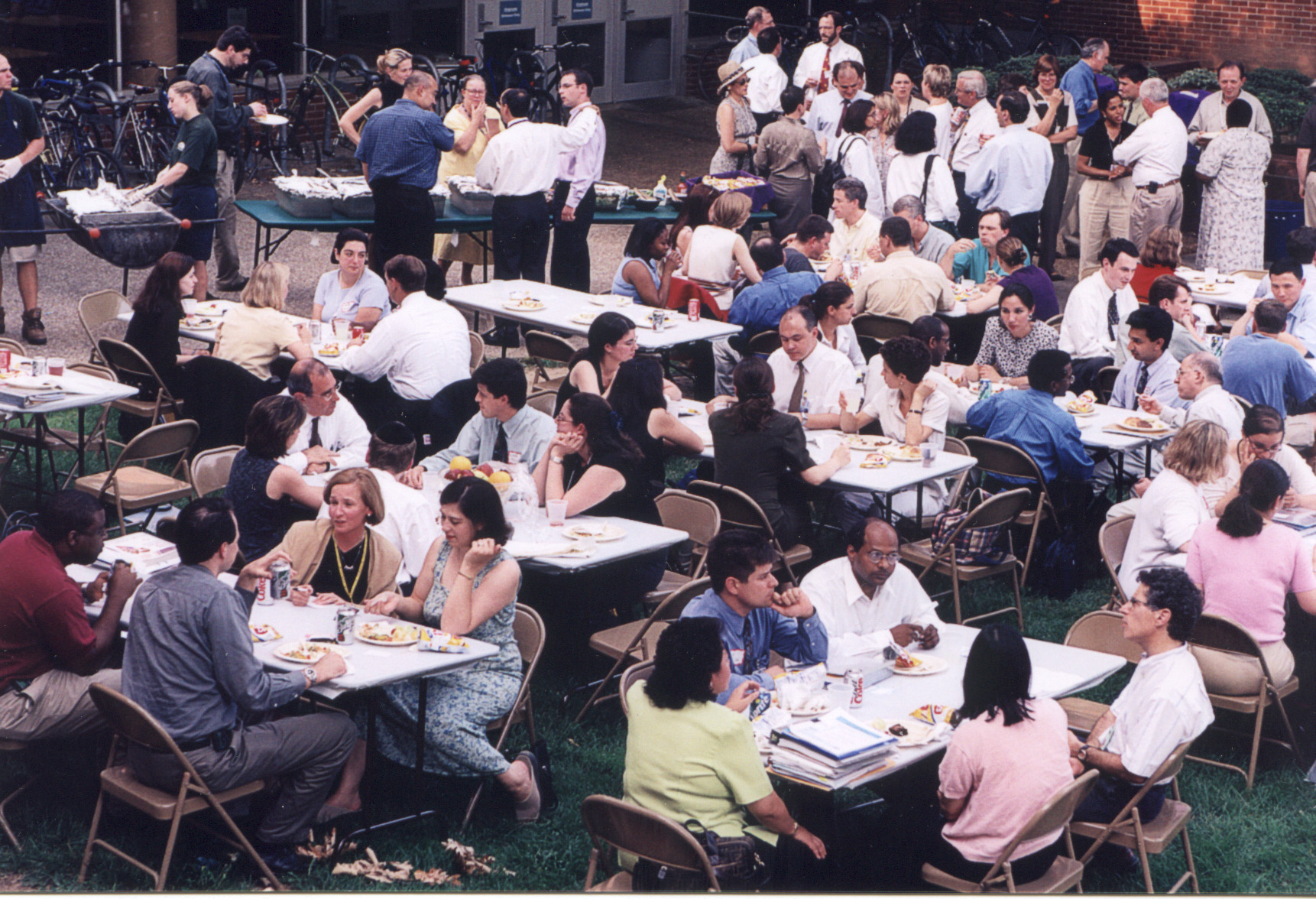
|
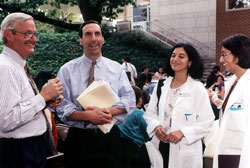
|
|
Back to Top
|
|
briefs
|
|
Share the Health forum
Join the NIH Office of Community Liaison for its fourth annual free community health forum,
"Share the Health: An Exposition of Health Resources from NIH to its Neighbors."
The event, which features health-related information, lectures, workshops, and
screenings, will be held on Saturday October 26, from 8:30 a.m. to 3 p.m. in the
Natcher Conference Center, Building 45. The event promotes health through the prevention
of diseases by offering the community access to NIH's vast resources.
Hispanic Heritage Month
The NIH Hispanic Employee Organization will hold it heritage month celebration
on Thursday September 19 from 9 a.m. to 12:30 p.m. in the Lipsett Amphitheater.
Speakers include U.S. Surgeon General Dr. Richard Carmona; Dr. Nilda Peragallo,
president of the National Association on Hispanic Nurses; and Dr. Carlos Zarate,
chief of the Mood and Disorder Research Unit, NIMH. An exhibit and reception will
be held from 12:30 to 2 p.m. in the Visitor Information Center.
Type O blood needed
The NIH Blood Bank is in urgent need of type O blood donors. Call 301 496-1048
to make an appointment at the Blood Bank (Department of Transfusion Medicine),
located on the first floor of the Clinical Center.
The Blood Bank is open Tuesday through Friday, from 7:30 a.m. until 5:30 p.m.
For more information visit http://www.cc.nih.gov/blooddonor/index.html.
Concession hours change
The concession store, located on the B1 level, has changed its hours to
accommodate employees who work evening shifts or late hours. The new hours are
from 6:45 a.m. to 6 p.m. and will remain that way for a two-month trial period.
The Office of Research Services made the change after receiving requests from
the Quality of Worklife and Diversity Council. The old hours, which were from
7 a.m. to 4 p.m., were not convenient for shift workers and did not allow
employees to buy food and snacks after hours.
Orientation fair
The NIH Office of Education, Office of Research Services, and Work and
Family Life Center will sponsor its annual new employee orientation fair on
September 18 from 10 a.m. to 1 p.m., in the Visitor Information Center. Based
on the theme, "Ask Me About the NIH," the event will showcase the wealth of
professional and personal services that are available to NIH trainees and employees.
For more information call the NIH Office of Education at 301-496-2427 or the Work
and Family Life Center at 301-435-1619 (TTY 301-480-0690).
Primary care updates
Join the Clinical Center Nursing Department for its sixth primary care
update seminar on September 18, 3-4 p.m. in the Lipsett Amphitheater.
Diane Seibert, M.S., CRNP, will present the topic, "Update on Hormone Replacement Therapy."
|
|
Back to Top
|
Editor:
Tanya C. Brown
Contributing
writers: John Iler and Rich McManus
|
|
Clinical Center News, 6100 Executive Blvd., Suite 3C01, MSC 7511, National Institutes
of Health, Bethesda, MD 20892-7511. Tel: 301-496-2563. Fax: 301-402-2984.
Published monthly for CC employees by the Office of Clinical Center
Communications, Colleen Henrichsen, chief. News, article ideas, calendar
events, letters, and photographs are welcome. Deadline for submissions
is the second Monday of each month.
Back to Top
|
|

